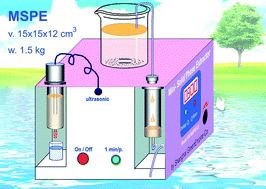Antibiotics provide vital treatment in fighting bacterial infection, but over time some have become phased out or even toxic to humans.

Miniaturized device for detection of chloramphenicol in water
One of these is chloramphenicol. Although banned in the European Union, chloramphenicol continues to be used as a cheap remedy in veterinary medicine and can lead to contaminated water and food for our consumption. One technique to test for this contaminant, solid phase extraction (SPE), purifies samples effectively, but requires a pump and a laboratory setting.
Alternatively, Sheng Liu, from the Chinese Academy of Sciences, and colleagues developed a simple yet portable miniaturized SPE (MSPE) device capable of detecting chloramphenicol in water, which has been difficult to test using other methods. A macroporous resin captures and concentrates the chloramphenicol before it passes through an HPLC, all within a 1.5 kg mass instrument. This new technique directly detects low concentrations of chloramphenicol in water, and demonstrates the capacity to function at contaminated locations.
To know more about the study, please click on the link below. This paper will be free to read for the next two weeks.
On-site solid phase extraction and HPLC determination of chloramphenicol in surface water and sewage
Sheng Liu , Xian-Zheng Wu , Zi-Hui Gao and Fang Jiao
Anal. Methods, 2013, Advance Article
DOI: 10.1039/C2AY26162F










